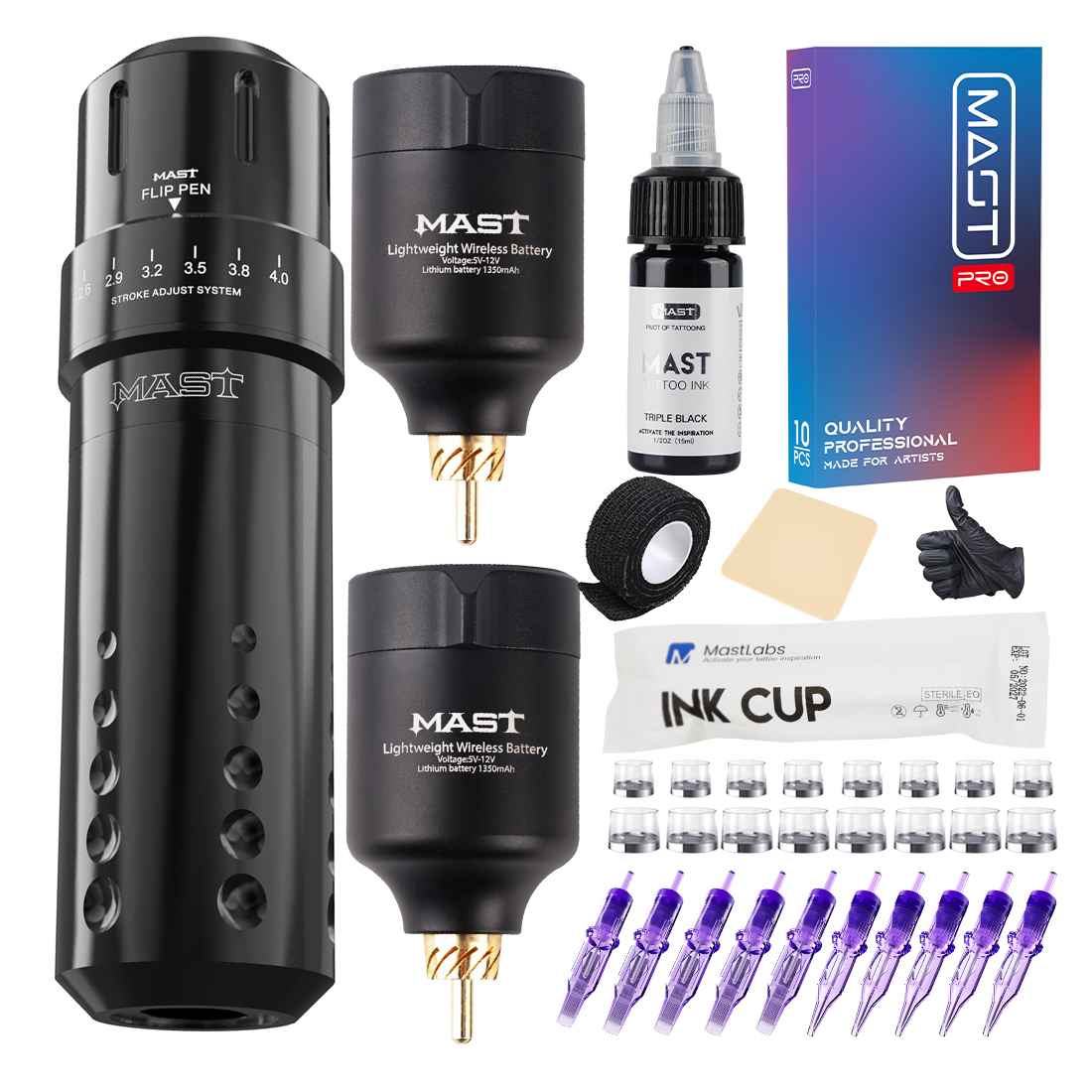In the quiet spaces between medical procedures and the gentle hum of healing, there exists a unique profession that fuses compassion with creativity: paramedical tattoo artistry.
In this world, artists wield needles not just to create visual masterpieces but to restore dignity and confidence to those whose bodies have weathered storms of illness and surgery.
Paramedical tattooing, also known as cosmetic, corrective, or reconstructive tattooing, provides specialized permanent makeup procedures for medical reasons. Training as a paramedical artist requires blending medical knowledge with artistic technique.
Follow this guide to launching a meaningful career helping clients restore function and confidence through skilled paramedical tattoos.
As we explore how to become a paramedical tattoo artist, you’ll discover how to be part of this noble profession of skilled individuals who use their craft to turn the page on pain, one inked story at a time.
Overview of Paramedical Tattooing
The field of paramedical tattoo artistry has emerged as a transformative force within the intersection of healthcare and artistic expression. As an evolving niche, paramedical tattoo artists play a pivotal role in helping individuals reclaim their sense of self after facing medical challenges.
Paramedical tattooing, also called corrective tattooing, involves:
- Advanced methods of camouflaging surgical scars through matching skin tone pigments
- Areola repigmentation to recreate nipples after breast reconstruction
- Scalp micro-pigmentation looking for closely shaved hair
- Permanent makeup procedures like eyebrows and eyeliner
- Subdermal illusion tattoos for skin augmentations
- Tattooing to cover up vascular birthmarks or pigmentation disorders
- Helping burn survivors, accident victims, and cancer patients feel whole again
Paramedical artists combine specialized training in color theory, realism, and medical processes with empathy and care to aid healing through their work.
That said, is it the right choice for you? Before we get on to show you how to become a paramedical tattoo artist, let’s take a look at some important points to help you know whether or not becoming a paramedical tattoo artist is the way to go.
Industry Stats
1. Rising Demand: With an increasing awareness of the emotional and psychological benefits of paramedical tattoos, there has been a notable surge in demand for skilled artists and it doesn’t seem to be stopping.
2. Medical Collaboration: Paramedical tattoo artists are forming collaborative partnerships with healthcare professionals, including surgeons and dermatologists. This collaboration aims to enhance patient outcomes by providing a holistic approach to recovery and post-surgery aesthetics.
3. Technological Advancements: The integration of cutting-edge technologies, such as 3D printing and advanced pigmentation techniques, is reshaping the paramedical tattoo landscape. These innovations allow artists to create more realistic and customized solutions for individuals with varying skin types and conditions.
Future Trends
1. Specialized Training Programs: Anticipating the growing demand for qualified paramedical tattoo artists, educational institutions are expected to introduce specialized training programs. These programs will cover not only artistic techniques but also the medical aspects of skin conditions and post-surgical care.
2. Broader Acceptance in Healthcare: As more success stories emerge, the acceptance of paramedical tattooing as a legitimate part of the healing process is likely to increase. Hospitals and healthcare facilities may start incorporating these services as part of their comprehensive patient care programs.
3. Global Recognition: Paramedical tattoo artists are gaining recognition on a global scale. International forums and conferences focused on the intersection of art and healthcare are likely to provide platforms for knowledge exchange and collaboration, fostering a sense of community among practitioners worldwide.
The future of paramedical tattoo artistry is promising, marked by a growing demand for skilled professionals, technological advancements, and increased integration into mainstream healthcare practices.
As the industry continues to evolve, aspiring artists can expect a wealth of opportunities to make a meaningful impact on the lives of individuals seeking healing and self-affirmation.
Also Read: How to Become a Fine Line Tattoo Artist. [The Complete Guide]
Benefits of a Paramedical Tattooing Career
Pursuing paramedical tattoo expertise offers meaningful advantages:
- Helps patients physically and emotionally recover post-surgery
- Provides a sense of purpose in healing trauma survivors
- More stable income than personal tattooing alone
- Less physically taxing
- Ability to open a private studio or work in a hospital
- Opportunity to regularly give back and change lives
- Varied work restoring confidence to a wide range of clients
- Chance to coordinate treatment as part of the medical team
- Combines creativity with technical training
Paramedical tattooing fulfills professional goals while transforming patient outlooks.
How to Become a Paramedical Tattoo Artist
I’ve given a brief overview and talked about the benefits of being a paramedical tattoo artist, it’s now time for the main gist of this article; how to become a paramedical tattoo artist. Here are the steps you must take to become one;
1. Earn a High School Diploma or Equivalent
Having a solid educational foundation in core subjects like math, science, and health lays the groundwork for future medical coursework. Strong reading and communication skills also help absorb training materials and interact with clients.
2. Get Training in Artistic Fields
Pursue classes or degrees in art, design, aesthetics, cosmetology, or related creative disciplines. Develop expertise in color theory, skin tones, facial anatomy, makeup application, and color blending. These artistic sensitivities inform realistic, natural-looking paramedical tattoos.
3. Study Medical Terminology
Learn root words, prefixes, and suffixes used in healthcare fields. This specialized vocabulary lets you accurately understand medical documents and client health histories. Strong medical terminology skills ensure clear communication with doctors and nurses.
4. Get First Aid and CPR Certified
Training in basic life support, the Heimlich maneuver, bleeding control, etc. prepares you to respond to emergencies on the job. Maintaining current First Aid/CPR credentials is required at most studios and medical settings.
5. Consider Becoming an Esthetician
Earning an esthetician diploma or certification provides a solid foundation in skin science, sanitation, facial procedures, makeup, and client interactions. Many esthetician program courses directly translate to paramedical tattoo skills.
6. Learn Permanent Makeup Techniques
Take specialized seminars and classes in permanent makeup tattooing. Training should cover procedures like microblading brows, scalp micropigmentation, lip blushing, scar camouflage, and 3D areola restoration.
7. Get Strong Anatomy Knowledge
Study detailed facial and body anatomy and physiology. Understanding muscles, nerves, skin layers, etc. allows for creating realistic, properly aligned, and shaded tattoos. Know what layer of skin to place different kinds of pigments.
8. Train in Needle Techniques
Practice tattoo motions on practice skin and synthetic models. Master depositing pigment into various scar tissues and grafted skin. Learn depth and patterns for dense versus sparse hair replication. Develop muscle memory and dexterity.
9. Shadow Experienced Paramedical Artists
Assist established paramedical tattoo artists regularly to learn their techniques firsthand. Observe their consultations, setup, tattooing motions, and post-procedure care. Ask questions in downtime and get feedback.
10. Earn Bloodborne Pathogens Certification
Passing a bloodborne pathogens class is mandatory for any tattoo artist or practitioner. These courses teach proper sanitation, cross-contamination prevention, needle handling, waste disposal, and exposure responses.
11. Get Licensed in Your State
Research what licenses or registrations your state requires for permanent makeup and paramedical tattooing. Some states require esthetician licenses or specialized microblading certificates. Comply with all regulations before working independently.
12. Build a Portfolio of Work
Document your training tattoos on consenting models. Demonstrate your ability to create natural-looking brows, scalp effects, areolas, and camouflage across diverse skin types and client needs. Let your portfolio showcase your style.
13. Continuing Education
Stay current through regular training workshops on new paramedical techniques. Attend medical and tattoo conventions. The field evolves constantly, making ongoing learning mandatory to remain skilled.
Also Read: Can You Become Amish If You Have Tattoos? Torn Between Ink and Simplicity
Important Tips on Becoming a Paramedical Tattoo Artist
In this section, let’s talk about other things that will be useful to you in your journey of becoming a paramedical tattoo artist. I will highlight points on finding tattoo programs, policies, finding work as a paramedical tattoo artist, dealing with clients, and list goes on.
Finding Paramedical Tattoo Training Programs
Look for esteemed paramedical tattoo certifications like:
- American Institute of Intradermal Cosmetics
- National Laser Institute
- Medical aesthetics courses for tattoo artists include bloodborne pathogens, needling, and vasculature.
- American Academy of Micropigmentation
- Classes in permanent makeup and scar concealing for burn survivors led by industry specialists.
Look for programs emphasizing medical protocols, reconstructive processes, skin physiology, and supporting patient emotional healing.
Paramedical Tattooing Specialties
Being a specialist will generally pay more than being a generalist. So, pursue training in specific corrective areas like:
- Scar Camouflage Tattooing
- Masking surgery scars through expert ink shading and color blending into surrounding natural skin. Mastering realistic flesh tones is key.
- Areola Restoration
- Recreating realistic 3D nipple pigmentation and areola after breast reconstruction using dimensional tattoo shading.
- Scalp Micro-Pigmentation
- Applying multiple pigments and dot patterns to the scalp for the look of closely shaved hair helps hair loss patients.
- Shadow Cosmetic Tattooing
- Enhancing the shape and definition of lips and eyes through subtle, natural-looking permanent makeup tattoos.
- Vitiligo Camouflage
- Blending hypopigmented skin associated with vitiligo for a more uniform appearance.
- Medical Alopecia Tattoo
- Simulating eyebrows and hairlines for those with alopecia universalis.
Specialize in the transformative techniques most meaningful to your interests and talents.
Also Read: How to Become a Tattoo Artist in Utah – Licensure, Training and Running a Tattoo Shop
Developing a Specialized Paramedical Portfolio
Assemble a stand-out portfolio of your corrective work. You can do this through various means like:
- Before and After Images
- Demonstrate visual improvements from your paramedical tattoos with patient consent.
- Focus on Quality over Quantity
- A few amazing examples show more skill than dozens of mediocre ones. Let your best work shine.
- Variety of Services
- Showcase range across scar camouflage, areola restoration, scalp micro-pigmentation, etc.
- Some Full Body Images
- Contextualize scar and pigmentation treatments within the whole patient canvas.
- Mind Meaning Over Aesthetics
- The emotional impact on patients matters more than artistic interpretation. But highlight realism.
- Written Patient Stories
- Include quotes and case studies about how your work enhanced patient self-image and recovery.
- Certificates Earned
- List any completed training programs, seminars, and certifications. Highlight medical coursework.
An impactful paramedical portfolio conveys skill, compassion, and how you uniquely help better patients’ lives. It will make you stand out and open up more opportunities for you than a shabbily done portfolio. Try to take your time in crafting it.
Finding Work as a Paramedical Tattoo Artist
Seek employment through:
- Plastic Surgeons
- Many reconstructive surgeons employ specialists in-house for better-coordinated patient aftercare.
- Cancer Centers
- Hospitals with oncology programs often keep paramedical artists on staff for survivors.
- Taxpayer Clinics
- County health departments sometimes offer subsidized treatment services.
- Private Paramedical Studios
- Open your clinic specializing in post-surgical correction and permanent makeup.
- Aesthetic Medical Spas
- Spas offering plastic surgery or injectables also provide related corrective tattoos.
Build close relationships with reconstructive doctors who value your paramedical skills for optimal cooperative patient treatment.
Best Practices for Paramedical Artist Interactions
Use these approaches when working with patients:
- Listen Compassionately
- Understand patients’ insecurities and goals. Offer emotional support throughout the process.
- Thorough Consultations: Set appropriate expectations. Explain techniques and outcomes realistically. Guide clients on most strategic placements and pigments.
- Coordinate Care with the Medical Team
- Communicate with surgeons and nurses to align tattoo work seamlessly with overall treatment plans and timing.
- Accommodations for Discomfort: Provide numbing cream/sprays. Offer breaks. Adjust body positions to limit pain.
- Trauma-Informed Approach: Use sensitivity in interactions with those who have endured major personal traumas or loss. Ask permission before physical contact.
- Privately Document Treatments: Discreetly photograph and take notes to track work while respecting privacy. Secure written consent.
- Support Aftercare: Provide detailed aftercare instructions. Be available for follow-up questions or concerns during healing.
Patients appreciate both your advanced skills and compassion during their difficult recoveries.
Also Read: How to Become a Tattoo Artist in Arizona: [Licensed, Reputable, and Profitable]
Pricing for Paramedical Tattooing Services
When establishing rates, consider the following:
- The extra training and certifications required beyond normal tattoo skills
- Comparable fees of other paramedical artists in your region
- The lower overhead of private studio vs. hospital employment
- Whether offering sliding-scale options for lower-income patients
- Session minimums for more involved reconstructions
- The non-cash value your work provides that also enhances patients’ lives
Given the specialized expertise and care involved, top-tier industry rates are warranted for quality paramedical tattoo work, but remain sensible to patient means.
Regulations for Paramedical Tattooing
Understand both standard tattooing laws and unique medical requirements. Here are some of them;
- Obtain bloodborne pathogen training and tattoo artist licensure in your state as a baseline
- Adhere to standard tattoo shop health codes for sterilization, even in medical settings
- Complete training courses meeting medical liability standards
- Follow protected health information rules and patient record-keeping laws
- Work under the required supervision of doctors in hospital facilities
- Observe Joint Commission safety guidelines if working in accredited hospitals
- Get liability insurance covering both tattooing and paramedical work
Navigate regulations carefully to legally, safely, and ethically practice advanced tattooing medical services.
Dealing with Paramedical Tattoo Artists’ Occupational Hazards
Every occupation and profession comes with risks and also safety measures to deal with them. As a paramedical tattoo artist, you’ll face some risks too which you can minimize through the following measures:
- Strict sterile technique using autoclave and disposable needles
- Frequent hand-washing and glove changes
- Avoiding contact with patient bodily fluids
- Careful exposure precautions with communicable illnesses
- Not working when experiencing cold or flu
- Getting the annual flu vaccine
- Staying current on hepatitis and tetanus vaccines
- Following safe sharps handling protocol
- Using proper tattoo machine vibration mitigation
- Employing good posture, seating, and hand health regimens
Making safety second nature is vital when providing hands-on medical tattooing.
Best Practices for Improving Your Paramedical Tattoo Skills
Strive to keep enhancing abilities by:
- Regularly reviewing fundamentals like color theory, needle configurations, machine set-ups, etc.
- Studying skin anatomy and physiology textbooks
- Attending medical and tattoo conventions and training seminars
- Shadowing surgeons and nurses to understand overall patient care
- Staying atop new paramedical techniques by reading journal articles
- Volunteering to practice at hospitals on reconstructive patients pro bono
- Building connections in the medical community to exchange knowledge
- Practicing consistently to hone realism, color matching, and shading
- Trying new pigments and needles as they emerge for better outcomes
Committing to ongoing learning both medically and artistically produces the best patient results.
Troubleshooting Common Paramedical Tattoo Issues
As a paramedical tattoo artist, you will face some problems on the job. Here are some of the common problems you’ll face and how to address them;
Color Mismatching: Have another artist critique and suggest better pigment blending. Review color theory. Take skin tone matching courses. Consider laser removal if unfixable.
Heavy Scarring: Use flesh tones in several layers for dense scarring rather than attempting full camouflage initially. Inform patients more sessions may be necessary.
Fading Pigment Over Time: Make expectations clear and offer discounted touch-ups. Use heavy-handed shading initially for longer-lasting results. Provide aftercare to avoid UV exposure.
Difficult Patients: Assertively stand your ground against unrealistic demands while remaining calm and compassionate. Involve doctors or social workers to intervene if needed.
Emotional Burnout: Practice self-care given frequent trauma exposure. Seek professional counseling. Set healthy boundaries. Take time off to decompress.
Recognize when to seek help or more education to overcome the not-so-common problems you’ll encounter in your practice.
Conclusion
In this article, we’ve talked about how to become a paramedical tattoo artist. I’ve shown you the steps you need to take to become one.
The path to becoming a paramedical tattoo artist is a unique blend of artistic skill and compassionate understanding. Aspiring professionals should prioritize comprehensive education, including specialized training programs and mentorship from experienced practitioners.
Staying updated on technological advancements and fostering collaborations with healthcare professionals are key to success in this evolving field. Building a portfolio that showcases both technical proficiency and empathy is crucial for establishing a meaningful career.
Becoming a paramedical tattoo artist is not just about ink on the skin; it’s a commitment to being a conduit for healing. By embracing the intersection of art and healthcare, individuals can make a lasting impact on the lives of those seeking physical and emotional restoration. Dedication, continuous learning, and genuine passion pave the way for a fulfilling career in this transformative discipline.
FAQs About How to Become a Paramedical Tattoo Artist
What is the average salary for paramedical tattoo artists?
It varies based on experience, studio type, and location. However, most paramedical artists earn $50,000 – $70,000 annually. Highly specialized procedures like nipple tattoos after breast reconstruction can earn $150+ per hour.
How long does the training take to become a paramedical artist?
Expect 1-3 years of intensive education across both art and medical fields. Some formal esthetics or nursing training may speed this timeline but plan for extensive self-study and apprenticing too. Licensure adds more time as well.
What is the main difference from regular tattoo artists?
Paramedical artists have specialized medical knowledge and a focus on reconstructive outcomes, not just aesthetics. They interface with doctors to support restorative goals. Their tattoos follow clinical protocols vs. pure custom artistry.
Does having a medical background help become a paramedical tattooist?
Absolutely. Training in nursing, dentistry, esthetics, or other healthcare fields provides an ideal foundation. It lends vital anatomy, sanitation, bedside manner, and procedural experience that translates directly.
What percentage of training is art versus medical skills?
Expect to spend approximately 40% of training time on art skills and 60% on medical knowledge and safety protocols. Advance artistic abilities first since they are harder to develop. Medical education can come from formal instruction.
Can nurses or doctors become paramedical tattoo artists?
Yes, medical background gives useful insight, but clinical professionals still must train extensively in tattooing technique, permanence, pigments, equipment, and artistry.
Do I need artistic talent to become a paramedical tattoo artist?
Absolutely. You must master realistic coloring, shading, line work and color matching. Medical knowledge alone cannot substitute for refined artistic tattoo skills.
Should I get licensed as a general tattoo artist first?
Yes, paramedical artists must still complete standard tattoo apprenticeship and licensing requirements in their state before specializing. Most medical facilities and doctors require this legitimacy.
Are bloodborne pathogen courses needed?
Yes, OSHA mandates completion of BBP training to understand contamination risks and safety precautions even when practicing in clinical settings. Proper tattoo sanitation is still vital.
Do I need a medical degree to work in hospitals?
No, but you will work under and refer patients to doctors. Some hospitals may require an RN or esthetician license to grant privileges. Many just require paramedical certifications.
Will health insurance cover paramedical tattoos?
Sometimes for reconstructive purposes depending on the plan. Permanent makeup is usually considered cosmetic. Advocate to insurers to cover your services.
Is numbing cream used?
Yes, strong topical anesthetics are recommended for scar tissue and extremely delicate paramedical work. Numbing allows better precision and comfort.
What machines are used?
Precision rotary machines like Penmates with quality lining needles like 3RLs allow the detail work needed. Some also use scalpels or dermapens for very superficial pigment depositing.






